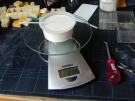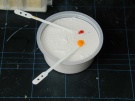 |
Getting the Right Mix |
Before you start mixing silicone, make sure you are
well prepared. Cleaning tissue, rubber gloves are useful if you want to keep
your hands safe, your working surface clean and your marriage together. To
make a perfect mix, a scale is useful (though I admit I used guesswork in
the past, and that worked well, too. Only when you use guesswork you always
end up with a leftover of one of both (expensive) silicone components.
You also need a disposable container to mix the silicone and something to
stir with. Those plastic thingies that fast-food restaurants offer to stir
the coffee work fine. In the background you see a LOT of the ammo boxes I
discussed above. They are easy to cast and always are useful for dioramas,
filling the truckload, etc... Notice that several of them are colored when I
used a dye to color the resin.
A good kitchen scale comes in handy. I explained to the missus that this is
indispensable to bake cookies. I admit I used it to bake cookies indeed.
Twice already. Maybe I should bake some next weekend to convince her that I
didn't just buy it for modeling purposes.
The screwdriver next to the scales is an interesting tool. It has a very
broad rim, and can be used as a mini-crowbar. I use it to remove lids from
paint jars, silicone pots, etc... Very handy!
I must have mixed silicone at least 100 times and resin a 1000 times by now.
Only a few months ago, I discovered the wonderful world of dye. Adding a
dash of color has several advantages. First of all, it makes mixing easier.
As long as you see streaks of dye or streaks of white in your mixture, you
know that you have not yet stirred the mixture well enough. This is
extremely important. If you do not mix both components of the silicone
extremely well, you get pieces that do not cure properly. If you have a mold
that has liquid pieces in it, you can throw it away and start all over.
Furthermore, uncured silicone is next to impossible to remove from your
original. It happened to me several times. There's a smiley for that.
A word of warning though. Don't use too much dye. The chemical component of
dye seems to influence the curing process if you use too much. I especially
had problems each time I mixed blue and yellow dye together to make green
molds or green resin. Reds and yellows work fine individually, and mixed
into orange, too. Copyright ©2002 - Text and
Photos by Jan Van der Cruysse (General
Failure). All Rights Reserved. |
| Project Photos


|

|













